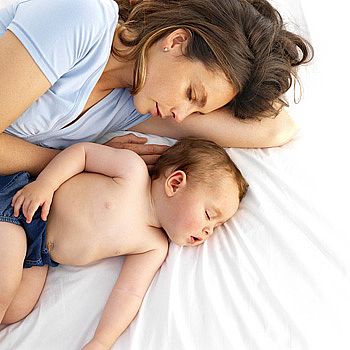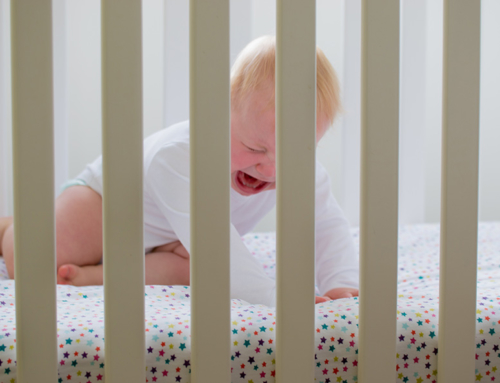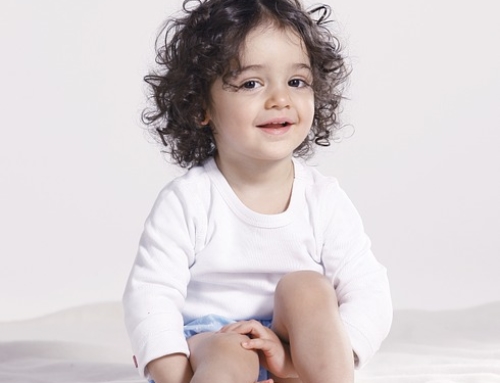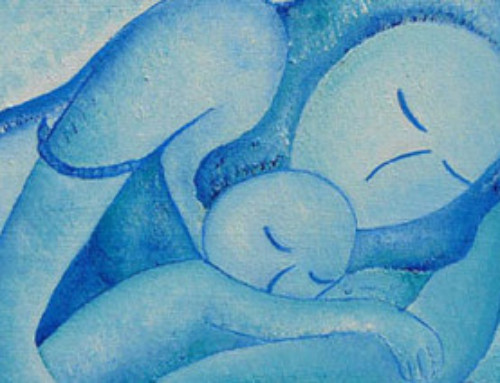
Since I interviewed Dr. Gerald Giesbrecht on my podcast and we talked about the link (or rather, the lack thereof) between attachment and sleep training, it seems to be a pretty big topic in the field of sleep, especially amongst families who practice gentle methods. It seems so logical that something like sleep training should affect attachment, right? Although I have covered this in more depth in another podcast interview with attachment researcher Dr. Levita D’Souza, I wanted to look at another study that examined this issue of overnight responsiveness and attachment status.
Back in 2009, Drs. Elizabeth Higley and Mary Dozier released the paper “Nighttime maternal responsiveness and infant attachment at one year” in the journal Attachment & Human Development. The argument for looking at nighttime stems from the notion that nighttime is particularly threatening to young humans which may require greater levels of responsiveness to build secure attachment – contrary to some recent findings.
To address this question, Drs. Higley and Dozier examined 44 infant-mother dyads for their overnight responsiveness (over 3 nights) and attachment status when infants were approximately 12 months of age (range was 11 to 14 months). Unlike previous (and later) studies in which maternal reports of responsiveness were used to assess the amount and type of nighttime responding, this study utilized videography and they had a median of just over 28 hours of footage per dyad. This is one reason why this sample is smaller than many later and larger studies – the time and effort it takes to analyze the hours of video for each family adds a considerable amount of work. Notably, all families had their babies go to sleep in a crib so there were no bedsharing-only participants (though many brought their baby to bed after a waking).
As videography was used, the researchers were able to assess a variety of sleep- and responsiveness-related variables, including:
- Bedtime: time in crib, whether put in the crib awake or asleep, whether infant cried before falling asleep
- Night wakings (for each waking): time awake, confidence that infant is awake, whether and how infant vocalizes, who responds to the awakening, latency to the response, how infant is put back to sleep
- Type of vocalizations: distress versus non-distressed, how clear they were
- Interactions with parents: amount of interactions, consistency of soothing method, effectiveness of soothing
All of these variables together allowed the researchers to develop a coding scheme that provided a single score for the overall pattern of nighttime responding. The first part of this global code was developed based on the response of the parents to the wakings. There were six possible codes given to each waking:
- No response/let cry
- Let cry at least 5 minutes then soothe
- Soothe in crib
- Pick up
- Increase physical contact (first soothe in crib then pick up)
- Multiple attempts/no clear pattern
The global score was based on the pattern over the three nights of awakening based on which of these codes was most frequent. This provided four groups of dyads:
- No waking or signalling (some kids didn’t signal distress)
- No response/let cry
- Pick up or soothe
- Multiple attempts/inconsistent
Mothers also provided self-report data on their infants’ awakenings and how they responded at night. Attachment was determined using the Strange Situation Procedure in the university laboratory. Finally, infant temperament was determined using maternal report.
What did they find?
Let’s start with just the base numbers. For attachment, 61% were classified as secure, 27% as insecure-disorganized, 7% as insecure-resistant, and 5% as insecure-avoidant. This 60% is in line with other research, but the rates of disorganized attachment are higher than one typically finds. However, given the small sample, the researchers utilized attachment as a dichotomous variable (secure-insecure). There were no temperamental differences between the groups based on attachment.
Next let’s examine infant nighttime behaviour. I want to start by saying that the degree of variability was huge and should serve as a point of calming for any family worried about their child. The number of awakenings at night ranged from 0 to 11 with an average of 3.77 (distressed awakenings ranged from 0 to 10 with an average of 3.12). Only 25% of families brought their babies to the adult bed after an awakening at least one of the nights examined so this was more of a solitary sleeping group of families.
Now we get to the interactions and there are some very interesting findings here. The first is to do with the clarity of signalling based on attachment status (and vice versa). Of the 27 secure dyads, 17 were clear signallers and 10 were not and this is compared to the insecure dyads in which 6 were clear signallers and 11 were not. This was not statistically significant (but very close). Another way to look at this is that of the clear signallers, 17 were securely attached while only 6 were not, but of those who were not clear signallers, 10 were securely attached and 11 were not.
Finally, we have the examination of how parents responded and the effects on attachment. Due to the small sample size, I discuss both significance and trends. There were 8 groupings for 44 dyads and this means it can be quite hard to reach significance when making comparisons. There was one significant finding (p<.05) and one near-significant finding (p=.06). First, the infants who were picked up and soothed at night as the general patterns were significantly more likely to be securely attached (n = 12 versus n = 2). This is in line with what many of us think about – this responsiveness to distress at night can help lead to a healthy, secure attachment for the majority (remember there were still 2 infants who did not show this pattern).
The trending finding was that for the no response group – that is, the infants who signalled distress but were not responded to – they were also more likely to be securely attached at a near-significant level (n = 8 for secure versus n = 2 for insecure attachment). This is in contrast to what many of us believe and yet mirrors some of the later studies which have sparked this discussion again.
Also trending, but not near significance due to low levels of participants, infants whose caregivers had inconsistent responses at night were more likely to be insecurely attached (n = 3 for secure attachment versus n = 7 for insecure attachment). This fits with number of children who had disorganized attachment and I would be curious to see what the numbers were here for that specific subgroup of children as it was relatively high. For infants who didn’t wake or signal, it was close to random (n = 4 for secure versus n = 6 for insecure attachment).
What do we take from this?
This matches what we’ve seen in other studies that doesn’t find a clear relationship to nighttime parenting and attachment status. It does provide evidence that being responsive and consistent at night is associated with secure attachment and some evidence that clear signalling is associated with secure attachment more generally. There is also good evidence here that the quality of nighttime sleep is not related to infant attachment. That is, the fear that night wakings may be a signal of poor attachment is just not borne out at all.
The question of whether or not one needs to respond at night to form secure attachment is not as clear. As the author’s themselves state: “[I]t is not simply whether the infant wakes or whether the mother responds to the infant’s fussing or crying during awakenings, but rather, for those mothers who generally do respond, whether the response is sensitive, consistent and in tune with the baby’s needs.” Again, this reminds me of Dr. D’Souza’s comments in our interview about the development of attachment classification and how it was based on a co-sleeping culture yet we still saw insecure attachment thus nighttime cannot be the only factor.
I am left with one larger question here and that is: What is the relationship to responsiveness at night for the clear signallers based on attachment? That is, as some children were more clear in their distress, how did the responsiveness for them play out?
I would imagine here that the clear signallers would do worse with the no response or inconsistent response than those who may not be signalling clearly. If we think about the numbers, there are 27 securely attached dyads, 17 of whom are clear signallers, 10 of whom are not. Of the 10, 4 will be the non-signallers by necessity of definition, and it’s unclear who the other 6 are. Are they the infants who were responded to inconsistently? Or not responded to at all? Or were they part of the 12 who were consistently responded to? If we think of the clear signallers more like orchid children, we can see how the type of response may be far more important for this subgroup, but we don’t know how the data fits with this.
I would also be interested to look at the clarity of signalling in terms of attachment given that later studies seemed to find babies were “less fussy” at a year if parents had utilized delays to crying or “cry out” (not necessarily at night though). This signalling is a good thing for our infants as they use it to inform us what they like, what they don’t, and our job as adults is to take this information in as best we can; not having it is not necessary a good thing. Children who are not as clear in their signals may be so because they know they aren’t being responded to or it may also go the other way – they may not signal well to start and this leads to a mismatch in responsiveness that leads to greater rates of insecure attachment. Seeing longer-term outcomes of this signalling issue seems to me to be a step that is needed in the research.
Overall, the study was small and helpful for what it was. The limitations in the methodology would make a larger-scale study much more difficult, but valuable given the means of assessment and the questions that can be answered. And more than anything, I think it does highlight again that consistent and sensitive responsiveness to our children’s distress does help build attachment. And that’s a good thing.
_________________
References:
Giesbrecht, G. F., Letourneau, N., Campbell, T., Hart, M., Thomas, J. C., Tomfohr-Madsen, L., & APrON Study Team. (2020). Parental Use of “Cry Out” in a Community Sample During the First Year of Infant Life. Journal of Developmental & Behavioral Pediatrics, 41(5), 379-387.
Higley, E., & Dozier, M. (2009). Nighttime maternal responsiveness and infant attachment at one year. Attachment & Human Development, 11(4), 347-363.






Leave A Comment